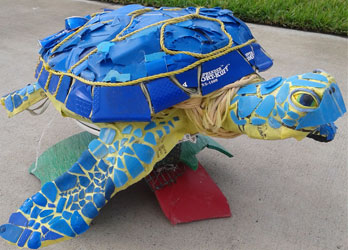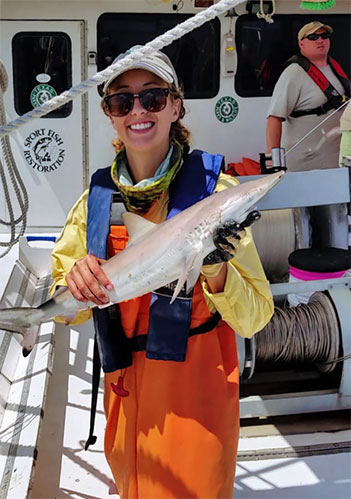Texas A&M Galveston student turns her love of sea life into a scholarship and works of art
 Taylor Cubbage, from Friendswood, Texas, with a double major in Marine Biology and Marine Fisheries at Texas A&M University at Galveston, is the recipient of the prestigious NOAA Ernest F. Hollings scholarship.
Taylor Cubbage, from Friendswood, Texas, with a double major in Marine Biology and Marine Fisheries at Texas A&M University at Galveston, is the recipient of the prestigious NOAA Ernest F. Hollings scholarship.
Taylor will be a junior this coming fall and plans to do research for a state or federal agency in an effort to protect sea life from hazards in the ocean. “I hope to land a career that allows me to carry out research focusing on how marine debris and microplastics are affecting our oceans and sea life,” said Cubbage.
 The NOAA Ernest F. Hollings scholarship provides both financial and professional development assistance to sophomores through their senior year. Over his long career in state and federal politics, Senator Ernest “Fritz” Hollings of South Carolina was a champion for ocean policy and conservation. When Senator Hollings retired in 2005, the Ernest F. Hollings Scholarship was established in his honor to bolster undergraduate training in NOAA mission sciences, as well as increase environmental literacy.
The NOAA Ernest F. Hollings scholarship provides both financial and professional development assistance to sophomores through their senior year. Over his long career in state and federal politics, Senator Ernest “Fritz” Hollings of South Carolina was a champion for ocean policy and conservation. When Senator Hollings retired in 2005, the Ernest F. Hollings Scholarship was established in his honor to bolster undergraduate training in NOAA mission sciences, as well as increase environmental literacy.
“Scholars receive $9,500 per year for tuition support,” said Cubbage. “In the summer between their junior and senior year they are provided with a paid internship at any national NOAA facility. Students can choose from a wide range of internship subjects from all branches of NOAA, from the National Marine Fisheries Service to the National Weather Service. At the end of the 10-week summer experience, all of the scholars return to NOAA headquarters in Silver Spring, Maryland for a symposium to display and communicate their work.”
Cubbage is also a Texas Parks and Wildlife Coastal Fisheries Division intern at the department’s Dickinson Marine Lab. Every year, the Texas Coastal Conservation Association sponsors about five interns to gain hands on experience in a professional setting with Texas Parks and Wildlife.
Cubbage was offered the resource monitoring position at the Galveston Bay location. She collected specimens from the bag of the seine net, otter trawl, oyster dredge and gillnet information to assess the abundance and status of the local fish and invertebrate populations of Galveston Bay. “This data provides an extremely reliable source of baseline information to facilitate scientific research, management and regulations to preserve the ecosystem,” said Cubbage. “We also carry out dockside fisheries surveys, asking the public to allow us to measure and identify their catch to assess local fishing pressure.”
Another exciting element of her job is helping with surveys that target shark species of the Texas coast. “A mile long line is dropped out with 100 hooks baited with mackerel chunks, allowed to set for an hour and then pulled in,” described Cubbage. “Everything caught is weighed and measured and any sharks are given special care, then tagged and released in hopes that it will be caught again. Growth as well as movement over time can then be determined.”
In addition to her work protecting sea life, Cubbage also tries to incorporate her love of art into her scientific outreach. “Last summer I created a giant three foot long sea turtle sculpted out of trash I found on Galveston’s beaches for an art contest,” said Cubbage. “I received the people’s choice award for ‘Debbie Debris,’ as I called her, and she now sits at Sea Center Texas in Lake Jackson, Texas to help educate children and families that visit the aquarium.”
She was then commissioned to paint one of the Seawall Interpretive Trail benches located near 37th and Seawall Boulevard in Galveston that also deals with the issues of marine debris.
